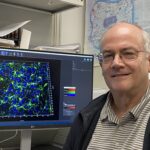NDRC Affiliated Faculty
Jaeda Coutinho-Budd

The Coutinho-Budd lab investigates neuron-glial and glial-glial interactions using Drosophila melanogaster, a really impressive genetic model with sophisticated cellular and molecular tools to investigate these questions in an in vivo system, and have recently begun to study this to understand the molecular basis of glial roles in neurodegeneration such as Alzheimer’s, Parkinson’s, and ALS. Using simple readouts like lifespan or locomotion to test specific candidates or screen through 100’s of genes, in combination with a number of cellular and molecular techniques, this lab aims to find novel glial genes that regulate disease severity and progression.
Sarah Flowers

The Flowers lab is focused on Alzheimer’s disease (AD) and how to identify and treat patients at the very early stages before the onset of damaging brain pathology, stopping the progression to AD. To achieve this we focus on APOE, the most important genetic risk factor in AD and use quantitative mass spectrometry, patient samples and stem cell models. We quantify carbohydrate modifications in the blood as a novel approach to monitor AD-related brain health and develop safe and effective therapeutic paradigms to treat the metabolic deficits we identify to extend the cognitive healthspan.
Alban Gaultier

Myelin, the insulating layer that covers axons in the brain, is affected in numerous neurodegenerative conditions, including Multiple Sclerosis and Alzheimer’s disease. Myelin defects precede neurodegeneration, presenting a unique therapeutic opportunity for neuron preservation. We research oligodendrocytes, the cells responsible for myelin production and repair, with the goal of identifying early therapeutic interventions to protect neurons.
Lulu Jiang

Our lab studies neurodegenerative diseases, with a focus on Alzheimer’s disease and related dementias (ADRD). Currently our lab has three main research directions: 1) we investigate RNA modifications and epitranscriptomic mechanisms in Alzheimer’s and related dementias to discover new treatment targets and diagnostic markers; 2) We create 3D human brain neuron-glial assembloids/organoids to study disease heterogeneity and develop personalized treatments; 3) We explore neuron-glia interactions and neuroimmunological mechanisms in disease progression for comprehensive understating of ADRD pathogenesis.
Chia-Yi (Alex) Kuan

I was trained as a developmental neurobiologist during my PhD and postdoctoral education, and for the past twenty years have focused on cerebral blood flow and metabolism (CBFM) and neonatal brain injury research. Yet, after I moved to the Department of Neuroscience at UVA School of Medicine in 2018, I began to expand my research into the aging brain, since that is an increasingly important topic in modern society with many unsolved enigmas and unmet medical needs. We are currently pursuing three neurodegeneration projects: the neurotoxicity of hyper-phosphorylated tau oligomers; a PET imaging probe to detect reactive oxidative stress in vivo; and the roles of microglia in vascular dementia and cerebral blood flow regulation.
Tsai-Yi Lu

Glia are frontline responders to brain insults and often become reactive during neurodegeneration. On the other hand, the degeneration of glial cells, especially the axon-wrapping oligodendrocytes, can also result in subsequent axon damage and diffuse neurodegeneration. The Lu lab is interested in deciphering this intricate interaction between neurons and glial cells during brain injury and neurodegeneration, with a particular focus on the physiological changes of oligodendrocyte lineage cells from health to the disease state. The Lu lab uses the mouse as a genetic model organism to simulate human neurodegenerative diseases and employs a variety of in vitro and in vivo methods, including primary cell culture, in situ hybridization, histology, and longitudinal in vivo imaging, to unravel the molecular and cellular mechanisms behind the complex neuron-glial interactions during neurodegeneration.
John Lukens

We are currently exploring how to harness the immune system to treat Alzheimer’s disease. In particular, our lab has been most recently engaged in studies to define how the major immune cell population of the brain, microglia, can be leveraged to limit neurodegenerative disease progression. Microglia are specially equipped to safely dispose of neurotoxic agents that can cause neuronal cell death. Microglia can become dysfunctional with aging and in response to various environmental and genetic factors. Our lab has been actively involved in efforts to uncover novel molecular players that can be therapeutically targeted to rejuvenate beneficial microglial responses as a strategy to prevent and/or reverse brain damage and dysfunction.
Mary Peace McRae
Harald Sontheimer

Neurodegeneration defines diseases associated with the progressive loss of neurons. The most typical examples are Alzheimer’s and Parkinson’s diseases. However, a number of neurological conditions are associated with secondary neurodegeneration, including malignant gliomas, epilepsy, and multiple sclerosis. The Sontheimer laboratory has been studying mouse models of several neurological diseases – including Alzheimer’s (AD), epilepsy, and glioma – for over 30 years. In AD, we are particularly interested in amyloid toxicity affecting astrocytes causing vascular dysfunction and break down of the blood brain barrier. Moreover, we found disruptions in extracellular matrix structures (perineuronal nets) being associated with memory loss in AD and with the development of seizures. Finally, our glioma work has identified glutamate release as a neurotoxic byproduct of tumor growth and cause for tumor-associated seizures.
Scott Zeitlin

Huntington’s disease (HD) is a devastating hereditary neurogenerative disorder that is caused by the expansion of a CAG repeat encoding polyglutamine within the Huntingtin protein, and it currently has no approved disease-modifying treatments. The Zeitlin laboratory has been using mice as a model system to study this disease since the discovery of the HD gene in 1993, and we have generated a variety of mouse models with deletions of Huntington-functional domains to understand its normal functions, and generated models containing expansions of the CAG repeat in the mouse HD gene to characterize pathogenic mechanisms. More recently, we used these HD mice to identify the optimum age to administer an HD gene-lowering therapeutic strategy, and we are also now using them to characterize the role of the meningeal lymphatic system, microglia proliferation/activation, and inflammasome activation in HD pathogenesis.
